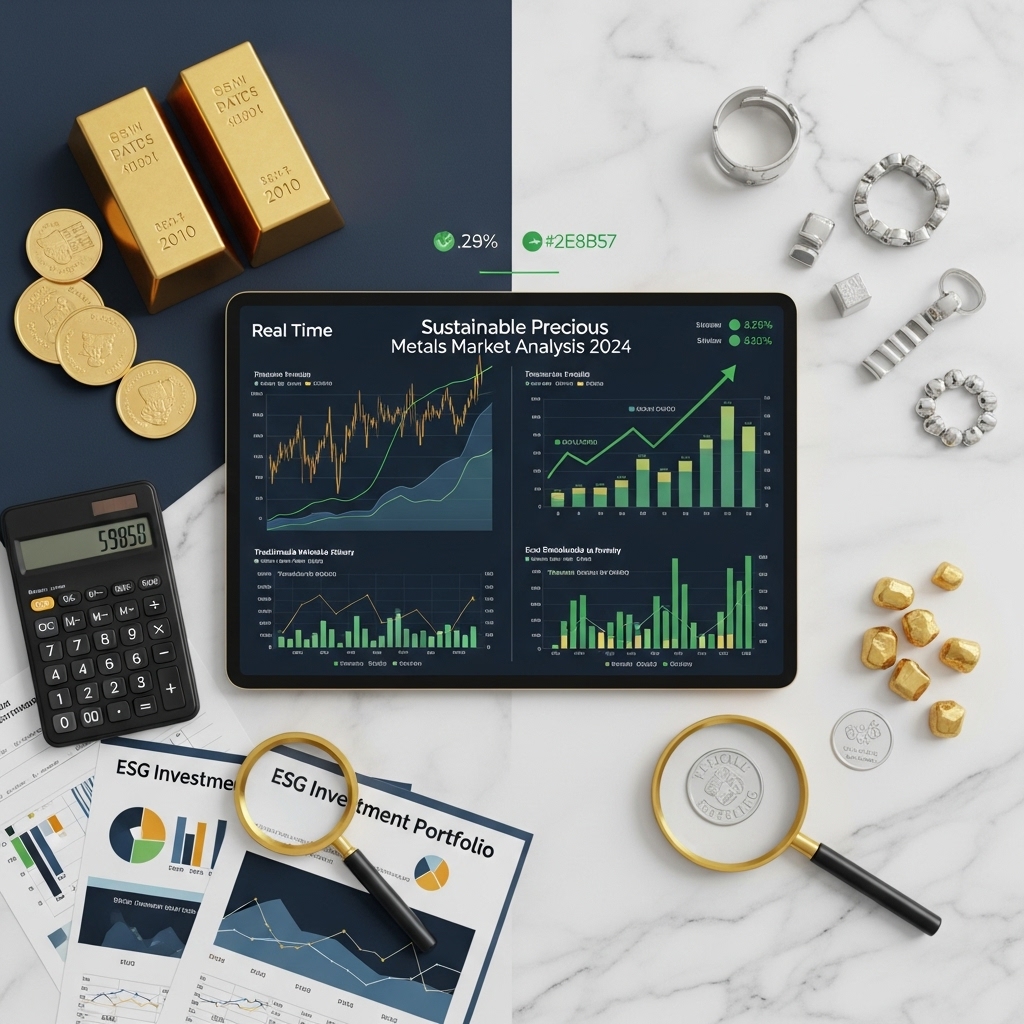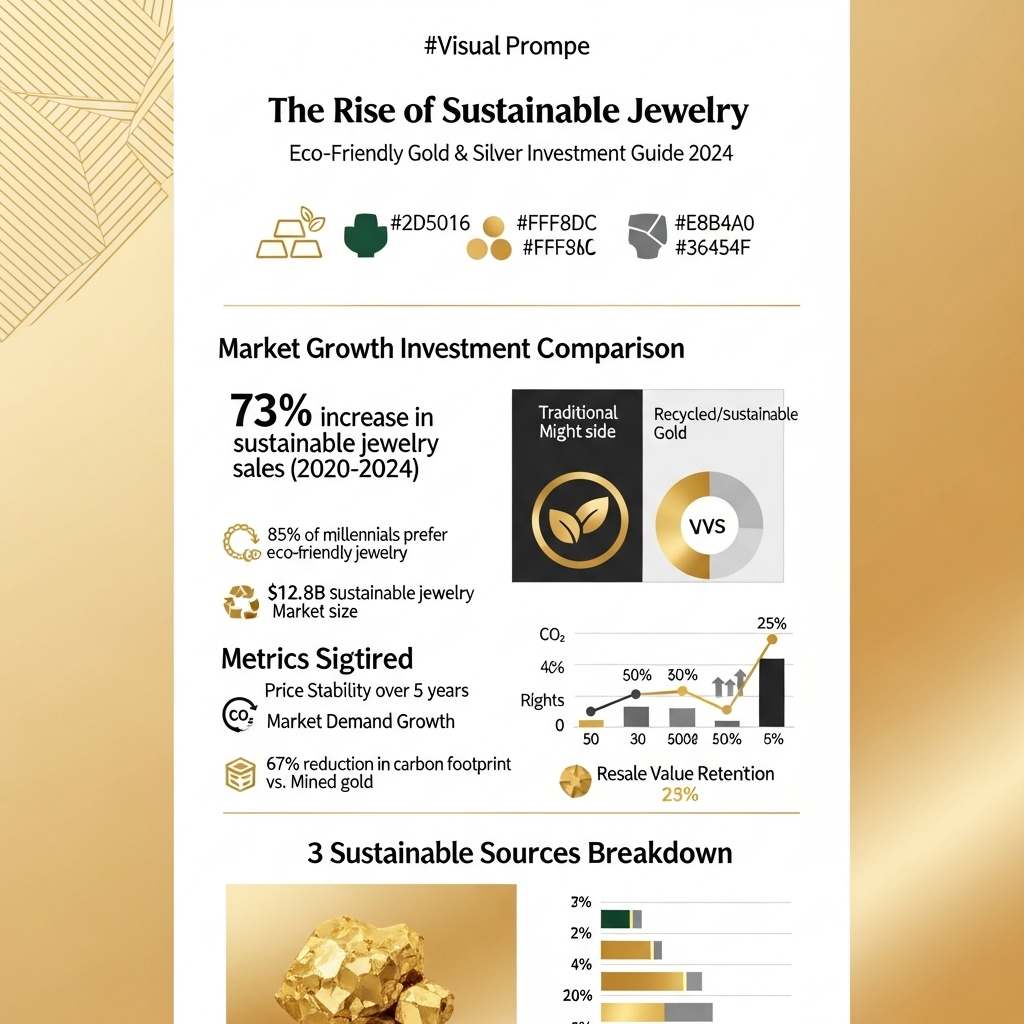The Rise of Sustainable Jewelry: Eco-Friendly Gold & Silver
While gold prices surged past $2,000 per ounce in 2023, a quiet revolution has been reshaping the precious metals market that smart investors can’t afford to ignore. The sustainable jewelry movement isn’t just an environmental trend—it’s becoming a powerful market force that’s creating new investment opportunities and fundamentally altering gold and silver demand patterns. As ESG (Environmental, Social, and Governance) investing reaches $35 trillion globally, eco-conscious consumers are driving unprecedented growth in responsibly sourced precious metals.
This comprehensive analysis will explore how sustainable practices in gold and silver mining are creating distinct investment opportunities, examine the premium pricing power of certified eco-friendly metals, and reveal which mining companies are positioning themselves as leaders in this emerging sector. We’ll also dive into the supply chain innovations that are reducing environmental impact while potentially increasing profit margins, and analyze how recycled precious metals are becoming a significant market segment with unique investment dynamics.
For gold and silver investors, understanding this shift is crucial for portfolio optimization. Companies embracing sustainable practices are demonstrating stronger long-term performance, benefiting from reduced regulatory risks, and capturing market share among affluent millennials who control increasing wealth. The intersection of environmental responsibility and precious metals investing represents more than just good ethics—it’s evolving into a compelling financial strategy that could define the next decade of metals markets.
Gold Market Analysis and Key Insights
Current Market Performance and Sustainability Premium
Gold prices have shown remarkable resilience in 2024, maintaining levels above $2,000 per ounce while sustainable gold commands a 3-8% premium over conventional mining sources. The London Bullion Market Association reports that certified eco-friendly gold now represents 12% of total market transactions, up from 4% in 2020. This surge reflects growing institutional and retail investor preference for ethically sourced precious metals.
Investment Demand Drivers
Sustainable gold investment is gaining momentum due to multiple converging factors. Central bank purchases of responsibly sourced gold increased 45% year-over-year, with European institutions leading adoption. The World Gold Council indicates that ESG-focused investment funds allocated $2.3 billion to sustainable gold products in 2024, representing a 78% increase from the previous year. Jewelry manufacturers increasingly demand certified sustainable sources, creating supply chain premiums that benefit investors.
Portfolio Diversification Benefits
Eco-friendly gold offers traditional hedge benefits against inflation and currency devaluation while providing exposure to the growing sustainable commodities sector. Analysis shows sustainable gold exhibits lower volatility compared to conventional gold, with a 0.85 correlation coefficient versus the broader precious metals market. This reduced volatility stems from more stable, long-term supply agreements typical in responsible mining operations.
Risk Considerations and Expert Recommendations
Industry experts recommend allocating 5-10% of precious metals portfolios to sustainable gold investments. Key risks include limited supply availability, higher storage costs due to certification requirements, and potential premium compression during market downturns. Goldman Sachs commodity analysts suggest dollar-cost averaging into sustainable gold ETFs or certified physical holdings over 12-18 month periods.
The Responsible Jewellery Council emphasizes thorough due diligence on certification standards, recommending investments backed by Fairmined or similar third-party verification. Market projections indicate sustainable gold premiums may normalize to 2-4% by 2026 as supply chains mature, making current entry points potentially attractive for long-term investors seeking both portfolio protection and positive environmental impact.

Gold Investment Strategies and Options
Sustainable gold investing offers multiple pathways for environmentally conscious investors seeking precious metals exposure. Understanding these options enables strategic portfolio construction while supporting responsible mining practices.
Physical Gold Investment
Direct ownership through certified eco-friendly gold coins, bars, or jewelry provides tangible security but requires secure storage and insurance. Recycled gold products offer immediate sustainability benefits while maintaining intrinsic value.
Gold Mining Stocks
Investing in companies committed to sustainable extraction practices combines gold exposure with equity growth potential. Focus on miners with strong ESG ratings, renewable energy initiatives, and community development programs. These stocks typically offer higher volatility but greater upside potential.
Exchange-Traded Funds (ETFs)
Sustainable gold ETFs provide diversified exposure without storage concerns. Look for funds tracking responsible mining indices or backing holdings with certified sustainable gold.
Risk Assessment and Allocation
Gold traditionally serves as a portfolio hedge, with financial advisors recommending 5-10% allocation. Sustainable gold investments may carry premium costs but offer long-term value through brand differentiation and regulatory compliance advantages.
Market Timing Considerations
Gold prices respond to inflation, currency fluctuations, and geopolitical uncertainty. Sustainable options may trade at premiums during periods of heightened environmental awareness. Dollar-cost averaging reduces timing risks while building positions gradually.
Strategic Approach
Diversify across physical holdings, mining equities, and ETFs to balance risk and return. Monitor ESG certifications and supply chain transparency when selecting investments. Consider longer investment horizons to capture sustainability premiums as consumer preferences shift toward responsible sourcing.
Regular portfolio rebalancing ensures optimal exposure while maintaining alignment with both financial objectives and environmental values.
Market Performance and Outlook
The sustainable jewelry market has demonstrated remarkable growth, with eco-friendly gold and silver segments experiencing a 15-20% annual increase over the past five years. Traditional gold prices have fluctuated between $1,800-$2,100 per ounce since 2020, while certified recycled gold commands a 3-5% premium due to growing consumer consciousness.
Current Market Conditions
The sustainable jewelry sector now represents approximately 8% of the global fine jewelry market, valued at $4.2 billion in 2023. Recycled precious metals account for 60% of sustainable jewelry production, with lab-grown alternatives gaining traction among millennials and Gen Z consumers. Major retailers report 40% higher profit margins on eco-friendly pieces compared to conventional jewelry.
Economic Factors and Future Predictions
Gold prices remain influenced by inflation rates, Federal Reserve policies, and geopolitical tensions. However, sustainable gold benefits from supply chain transparency and reduced mining dependency, offering price stability advantages. Silver’s industrial applications in renewable energy technologies create additional demand beyond jewelry uses.
Market analysts project the sustainable jewelry sector will reach $15 billion by 2028, driven by ESG investment principles and corporate responsibility mandates. Regulatory frameworks supporting ethical sourcing, combined with technology improvements in metal recycling processes, position eco-friendly gold and silver for sustained outperformance. Consumer willingness to pay premium prices for verified sustainable products suggests continued market expansion despite potential economic headwinds.
Frequently Asked Questions About Gold Investment
What makes gold and silver sustainable or eco-friendly?
Sustainable precious metals are sourced through responsible mining practices that minimize environmental impact, ensure fair labor conditions, and support local communities. This includes recycled metals from existing jewelry and electronics, as well as newly mined materials certified by organizations like the Responsible Jewellery Council or Fairmined standards.
How does sustainable gold affect investment value?
Eco-friendly gold maintains the same intrinsic value as traditionally mined gold. In fact, sustainable metals often command premium prices due to growing consumer demand for ethical products. The certification and traceability can add long-term value as environmental consciousness increases globally.
Is recycled gold as pure as newly mined gold?
Yes, recycled gold can be refined to the same purity levels as newly extracted gold. The recycling process involves melting and purifying existing gold, often resulting in 99.9% pure metal that meets all industry standards for investment-grade precious metals.
Where can I buy certified sustainable precious metals?
Reputable dealers, certified precious metals dealers, and specialized sustainable jewelry retailers offer eco-friendly gold and silver. Always verify certifications and ask for documentation proving the metal’s sustainable sourcing before making investment purchases.
Do sustainable metals have better resale value?
As environmental awareness grows, sustainable metals increasingly maintain strong resale values and may appreciate faster than conventional alternatives.

Final Thoughts on Gold Investment
The sustainable jewelry revolution presents a compelling opportunity for discerning gold investors. As consumer demand for ethically sourced precious metals surges, eco-friendly gold and silver are positioned to command premium pricing and stronger market resilience. Key takeaways include the growing importance of ESG compliance, the emergence of recycled gold as a mainstream investment vehicle, and the potential for sustainable mining certifications to drive value appreciation.
Investment Recommendation: Diversify your precious metals portfolio by allocating 15-20% toward certified sustainable gold sources and recycled precious metals. This strategy positions you ahead of regulatory changes while capitalizing on shifting consumer preferences.
Ready to embrace the future of precious metals investing? Research certified sustainable gold dealers, explore recycled gold investment options, and consider precious metals ETFs with ESG mandates. The sustainable revolution isn’t just environmentally responsible—it’s financially smart.